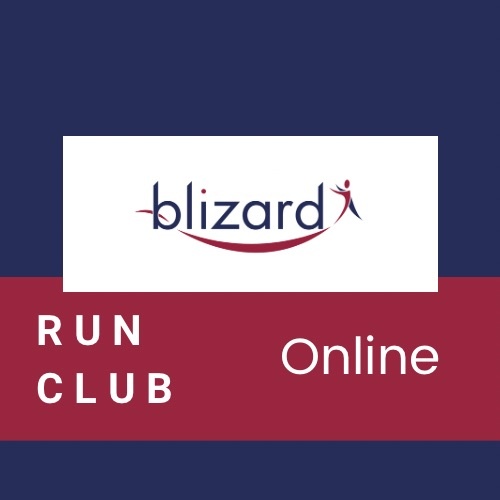
We help the 40+ year old runner reduce the rate of inevitable age related declines in performance.
You don’t have to be 40+ though to use Blizard Run Club Online. You can gain benefit at any age!
The 40+ year old runner is a unique athlete with special requirements!
See if you can align with the runners frustrations in these two scenarios.
Scenario 1
You are a lifelong runner who hits age 40 and feels their running days are over. You start to notice feeling a bit stiffer in a morning, taking longer to get into a running stride and notice despite running the same as you always have, your running times start to decline. Your response is to run harder and add some more miles as you think you are not doing enough. You start to feel tired after the harder sessions and pick up niggles, so then take a day off to recover but then you feel even stiffer to get going and more niggles appear and despite the continued effort your performances continue to decline and so does your motivation, confidence and enjoyment. You become really despondent and wonder why you are bothering anymore. You stop meeting up with your running friends in case the niggles cause you to stop and hold everyone else “back” but then you never get “back” running with your friends. What was once part of your daily life for years and years becomes a source of severe frustration. All you want to do is run and cross training just doesn’t cut it!
Scenario 2
You decide to do something “big” for your 40th birthday. You have steadily noticed your body weight increasing and you are feeling generally unfit so you enter a half marathon or a marathon as your big target to aim for. You start with a “Couch to 5K” program but almost immediately you start to pick up niggles, you hobble down the stairs every morning and limp when walking. You persevere because you made a plan but it feels so much harder than you thought it should do. You take extended periods of no running because the niggles just get too painful to run with, but as soon as you start back the niggle is still very apparent but now you have niggles elsewhere too. What seemed like a good healthy plan has left you feeling despondent and disappointed with yourself. The worst bit however is the fact you told your family and friends to provide accountability.
This is me…..help!
Both of these scenario’s result in the same cycle of reducing fitness due to not being able to run consistently, frequently and with adequate volume (miles run) to maintain or improve your overall running pace, time or achieve your running goal.
Putting the actual running itself to get faster/maintain fitness to one side for now, there are a whole host of other well researched age related factors that affect your running performance.
The good news is that the 40+ age group is the biggest growing age bracket in running and so it follows that there is a lot more clinical interest and research being undertaken to help this unique age group.
The primary aim of Blizard Run Club Online is to keep you running well into your forties and beyond.

What the research says in brief* (plenty more on Blizard Run Club!)
MUSCLE CHANGES
◾️ SARCOPENIA is a scientific name for the loss of muscle mass, strength and function as we age. The changes in muscle with advancing age is characterised by overall declines in SIZE and NUMBER of skeletal muscle fibres. Loss of muscle mass affects people from approximately 40 years of age and you can expect to lose 30-50% in muscle mass by the age of 80 (if you don’t do anything about it).
GAIT CHANGES
◾️With advancing age there is a decrease in stride length due to the reduced ability to generate force to move forwards.
◾️Along with this change is a corresponding increase in stride rate or cadence “the masters shuffle” to attempt to compensate for the lack of force generation.
◾️Senior athletes exhibit maximal ground reaction forces of 3 x body weight. Basically the higher the ground reaction force is the more propulsive force you will be able to generate to move forward. In masters athletes there is a steady decline in maximal ground reaction forces and an increase in the time spent in contact with the ground.
◾️Compared to senior runners, masters athletes maximum joint ranges of motion during running at the hip, knee and ankle are reduced. Rather than this being due to movement loss it is an attempt to lessen the impact forces generated at the joints due to reduced muscle strength to stabilise these joints
THE FOOT, ANKLE AND CALF MUSCLES
◾️RUNNING ECONOMY (RE) is defined as how much oxygen you use at a given running speed. Given that the availability of oxygen to the working muscles determines how fast you run and when you have to slow down, RE is an important determinant of running performance. Many factors influence RE such as training background, gender, bodyweight, footwear, running technique, age and anthropometrics (size and proportion of the human body). Of significance though, is that the energetic cost of running has been highly correlated with the work of the calf muscles and in particular the SOLEUS muscle. Strength training improves the size and action of this muscle which means running basically will feel a lot easier
◾️ In addition the main joint of forward momentum when running is the ankle joint which contributes a huge 41% and guess what… the SOLEUS muscle is the main contributor to ankle joint plantar flexion (the ankle opens up at the front as you move forwards onto your toes when running). Hopefully by now you can understand that the soleus muscle is perhaps the most important muscle to strengthen to affect your running performance
◾️ Specific foot strengthening exercises performed regularly for a 3 month period have a lasting effect on reducing the incidence of running related injuries (RRI’s) for a full 12 month period. In addition the research highlighted that the incidence of a stress fracture in the group performing the foot strengthening exercises was nil compared to the group who just continued there usual training
ACHILLES TENDON
◾️Achilles’ tendon issues are the most common injuries experienced by the 40+ age runner
◾️Excellent calf strength and function is the biggest protection against achilles injuries
◾️Achilles tendon stiffness plays a huge factor in Achilles’ tendon injuries. A 20% reduction in Achilles’ tendon stiffness is observed in individuals with Achilles tendinopathy and interestingly in the 40+ age athlete there is a 17.1% reduction in Achilles’ tendon stiffness compared to the younger population. Maybe there is a strong correlation here?
◾️The Achilles’ tendon behaves like an elastic band. If you try to lengthen the Achilles’ tendon it has a tendency to want to spring back to its original length. Running utilises this natural mechanism saving the calf muscles from having to carry out unnecessary work. Muscles require oxygen to work, whereas the spring in your tendons doesn’t. With age the Achilles’ tendon loses its stiffness and therefore has a reduced capacity to spring back to its original length. Strength training and in particular plyometric training has been shown to improve tendon stiffness in the ageing athlete and is a key component of Achilles’ tendon rehabilitation programs
THE HIPS
◾️Research has shown that there is a common gait pattern associated with injured runners and it relates to how strong the hip stabilising muscles are. In the research performed it was noted that for every 1 degree increase in pelvic drop, there was an 80% increase in the odds of being classified as being injured. This basically means that when your foot is fully in contact with the ground the pelvis should remain level but with the common gait patterns in injured runners the pelvis drops on one side. This can be altered with exercises focusing on strengthening the hip stabilising muscles
◾️There is a reduction in groin strength as a precursor to a groin injury. This weakness is usually maintained as long as the groin injury is present, with the athlete only returning back to full activities once strength has been restored
◾️When we compare athletes with groin pain and without, we see an increased weakness in hip adduction (muscles on the inside of the thigh) in the athletes with groin pain, particularly on the side that has groin pain.
◾️Athletes demonstrating a hip adduction strength deficit compared to their hip abductors (muscles on the outside of the hip), has been associated with the athlete experiencing a future hip or groin injury
STRENGTH TRAINING
◾️ Running alone is insufficient to prevent the decline in muscle qualities as we age. A well designed resistance training program is critical to any injury prevention and rehabilitation program for the ageing runner
◾️In a large scale study strength training was found to reduce the risk of overuse injury by at least 50%. In the same study they found that stretching alone had no protective effect against injury. It was concluded that master runners should prioritise strength training over stretching
◾️ In the 40+ athlete the rate of adaption to the body is slower so it is recommended that strength training should be at least 6 months in length and progressed slowly to provide sufficient stimulus for improvements to be seen
◾️Improvements in RE of between 4 and 5.3% have been reported in research on athletes undertaking strength training compared to a group just running
◾️Similarly, a 4% improvement in a 3km time trial performance under the same research conditions has been reported
◾️Strength training improves the resilience of bones to loading repeatedly reducing the incidence of stress fractures. With running being the number 1 sport for stress fractures, a single heavy strength session on the legs stimulates better bone cell growth that is equivalent to running a marathon
◾️Weaker muscles increase stress on bones through the impact forces of braking and torsional “twisting” stressors on bone. When you get tired your muscles are less able to stabilise the joints (hip, knee, ankle and foot) with every increasingly fatiguing foot strike. Not only that, weaker muscles allow tendons (that attach muscle to bone) to exert greater forces, so the risk of avulsion fractures (where the tendon pulls part of the bone away) increases
◾️Strength training improves the number of muscle fibres and the rate of contraction of muscle fibres. This means that you are capable of producing a higher and quicker force to move forward, increasing your stride length and thereby reaching the finish line quicker
◾️Conversely with age, there is a reduced proportion of type 1 muscle fibres (utilised to generate force) at the expense of type II muscle fibres (utilised to maintain endurance) but this means that the aging athlete has a reduced capacity to generate propulsive force to move forward and in effect more time is spent with foot in contact with the ground rather than moving forward
◾️Strength training improves the co-ordination and control of muscles, improving stability around joints and thereby reducing the oxygen cost of running
◾️Increased thickness and density of the Achilles’ tendon and the calf muscles that the Achilles’ tendon attaches to results in a stiffer tendon capable of storing and releasing elastic energy rather than using costly oxygen
Muscle Mass Extremes. Which Would You Rather Be?
In this study from 2011, they looked at how chronic endurance exercise preserves lean muscle mass in the ageing population. This study looked at two extremes and it serves to highlight the difference in a 70 year old lifelong exercising triathlete compared to a 74 year old sedentary individual. What it is NOT comparing however is the muscle mass of a young athlete compared to a masters athlete. It does however give you a rather shocking but positive reason to keep exercising!


Here is a brief of what you will have access to when you sign up to Blizard Run Club Online.
All for less than two coffees per week!
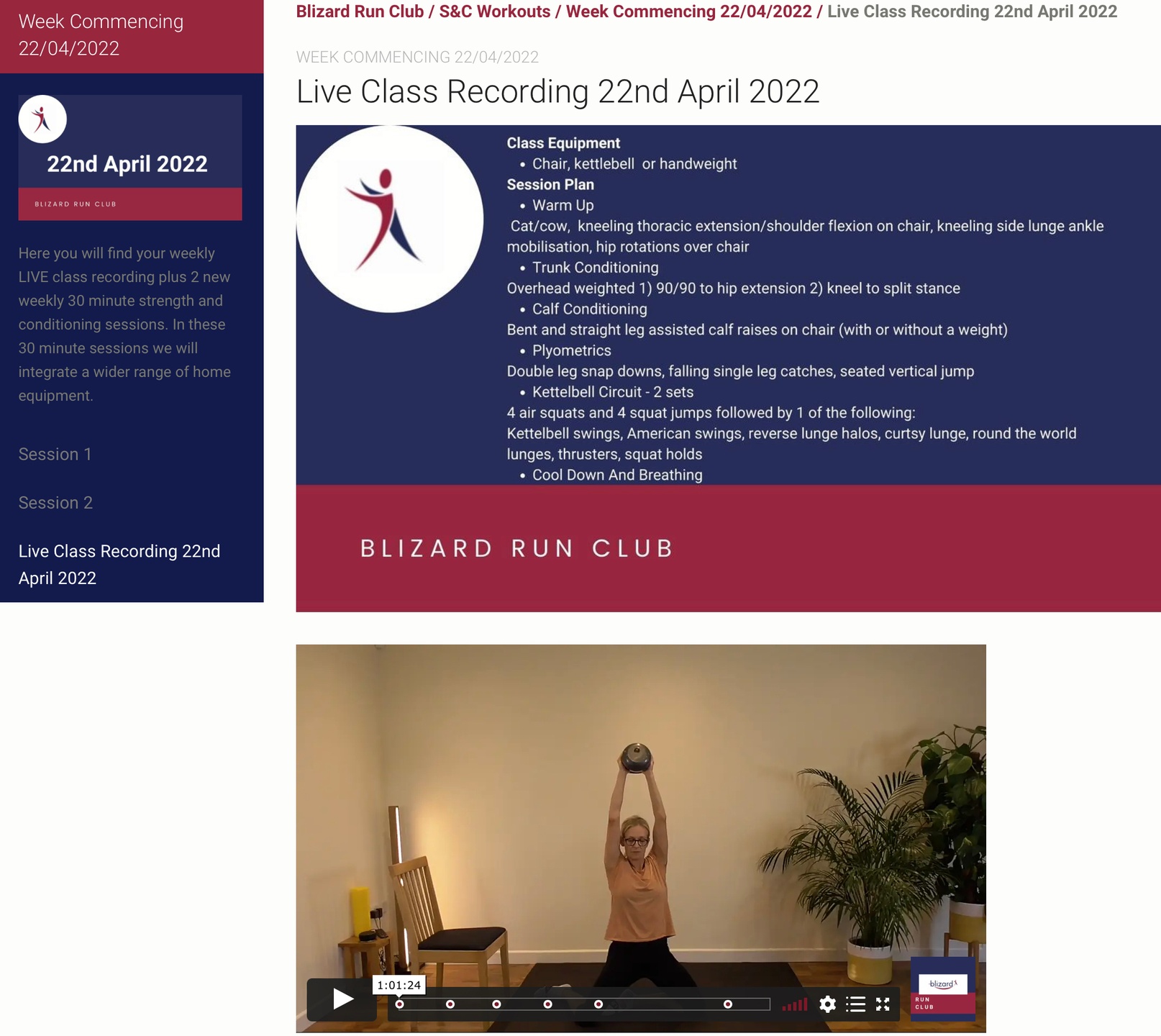
Live Class
This LIVE class takes place every Friday at 6pm and is different every week. Can’t make the live class? A quality recording of the class will be uploaded afterwards and be available permanently. Chapters and a full breakdown of the class will be provided so you can navigate to the exact sections in the class rather than having to scroll and scroll.

Strength And Conditioning Sessions
Every week you will have the option to complete a further two 30 minute workouts. A full breakdown of every session will be provided so that you can easily navigate back and forth through all the sessions or just follow along each week with a new routine. Again chapters are also provided so that you can navigate to certain parts if you want to refine and improve on a certain exercise or technique.
An 8 week beginners block is also available on the platform for those new to strength and conditioning.
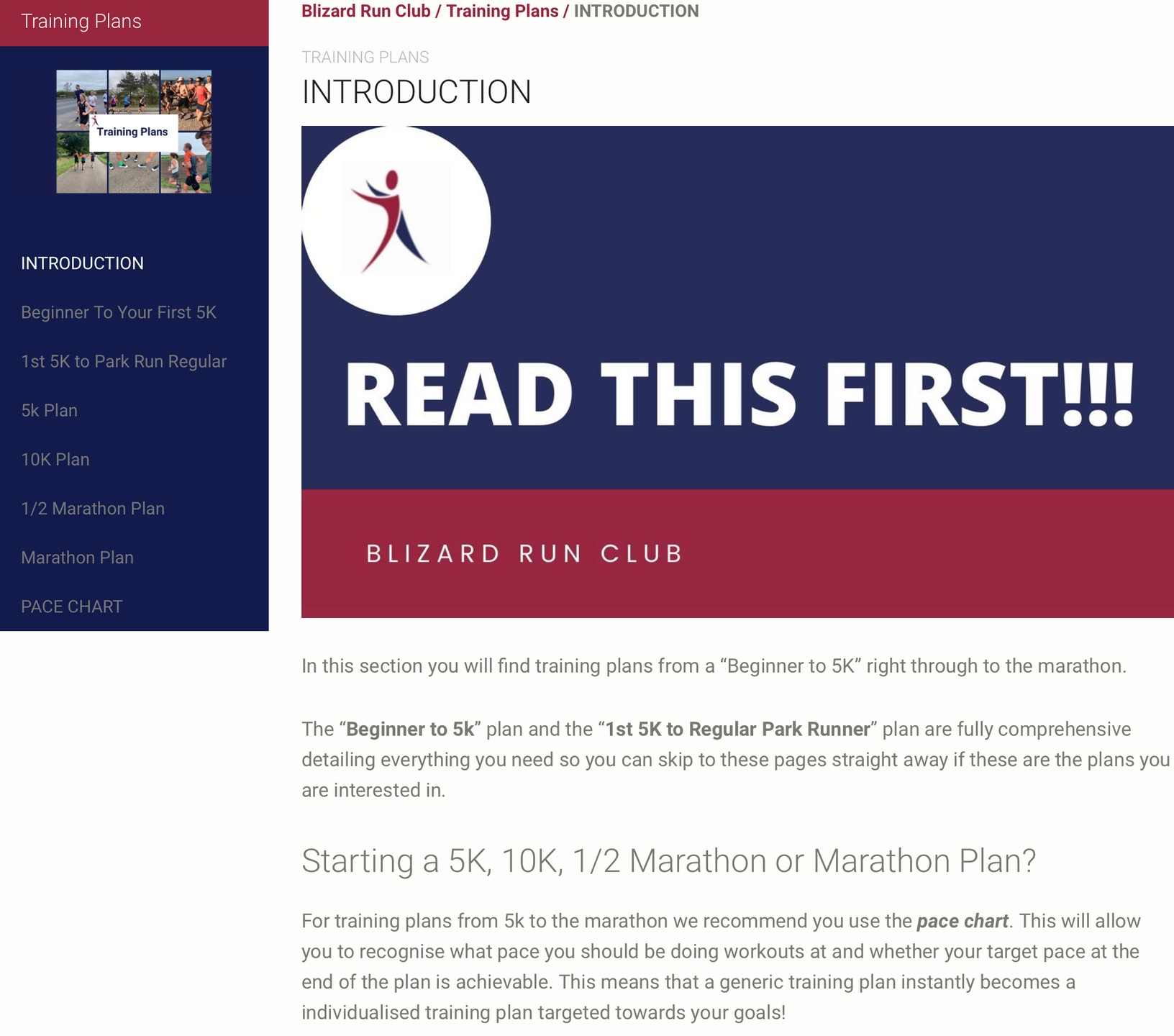
Training Programs
We are really excited about this section!. We have added comprehensive training programs from “Beginner to 5K” right through to the marathon. All the sessions are explained in detail. We have also included a pace chart so that you can totally individualise each program exactly to your needs. Using the pace chart you can work out an equivalent performance of what you would expect to achieve at a new distance and also work out your training paces for every session for every training plan.
The “Beginner to 5K” is a very comprehensive program in itself, with advice on what to do in the weeks before even starting the program, a weekly plan (not just the running bit) and weekly tips on technique.
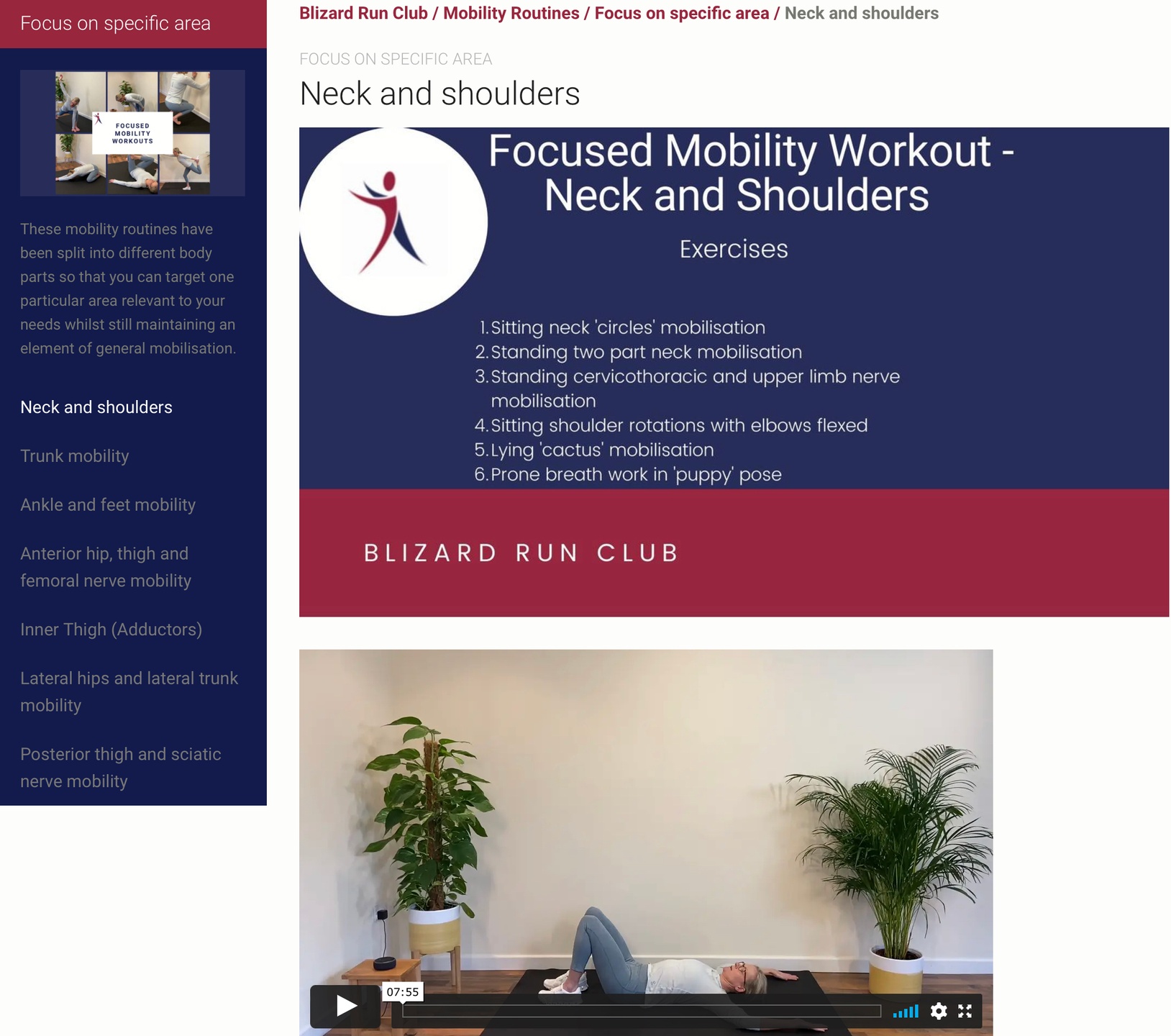
Mobility Sessions
There are 14 mini (less than 10 minute) mobility routines available to choose from. These are either focussed routines on a particular area for example, the foot or the hip, enabling you to target areas that you as an individual feel you need to work on or you can choose from one of the 7 general full body mobility routines. A full breakdown of all the exercises in each session is provided.
In addition we have extended mobility routines as well as all the routines we use often in the LIVE class.

Technical Run Drills
We have a dedicated section with sessions of technical running drills. Using these running drills isolates parts of the running action. The nervous system coordinates the sequences of muscular action more effectively, improving running efficiency and reducing compensatory movements.
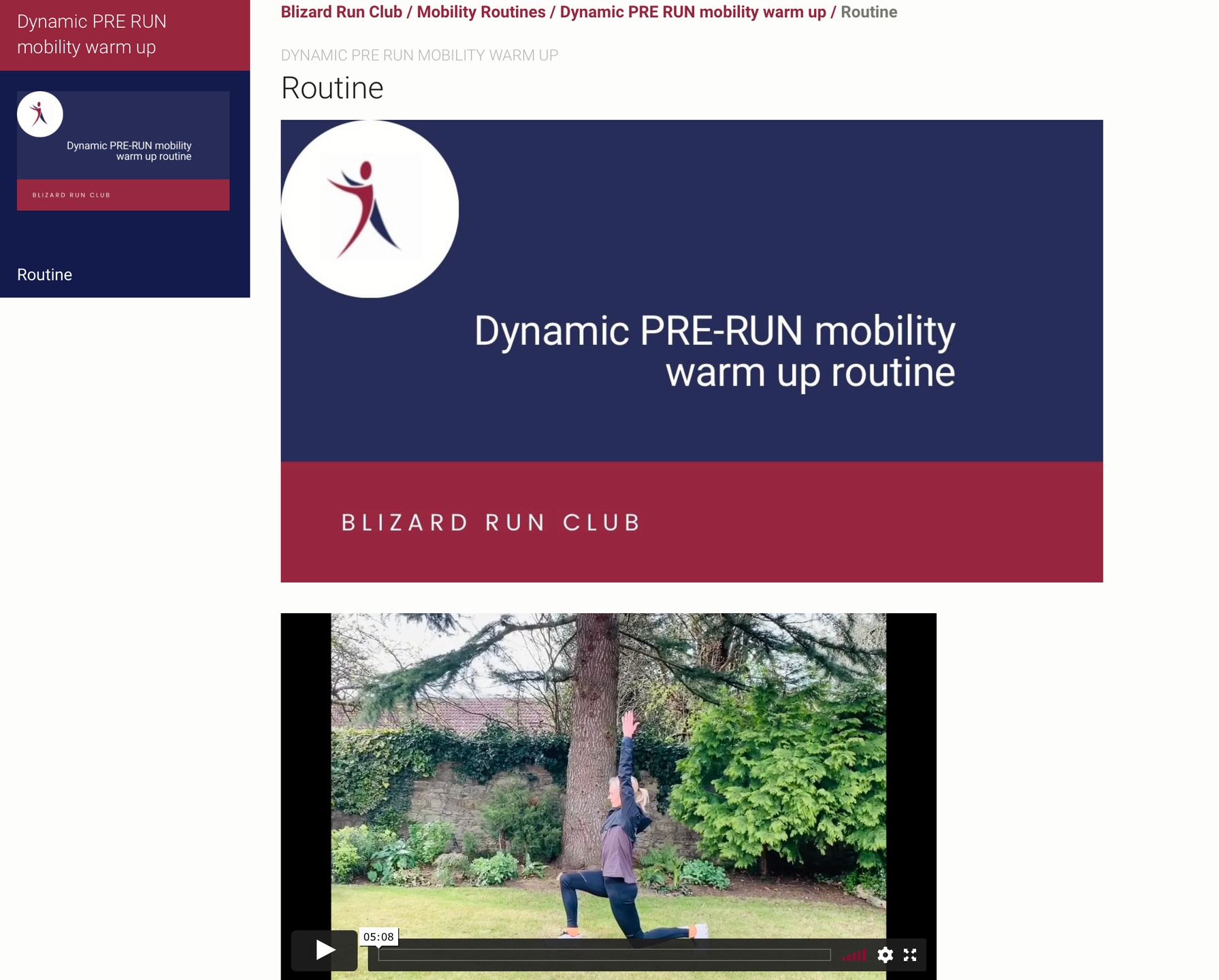
Dynamic Pre-Run Warm Up
A follow along video with instructions for how to perform each exercise has been provided so that you can really focus on your pre-run warm up.

Articles
These are research driven articles. We only provide information that we have critically analysed and assessed to be robust and relevant to what you need as a runner, so you can trust us to provide you with the latest information. All articles will be available for you in one place and we will continually be adding more for you to read.

Pace Chart
We have included the official Jack Daniels pace calculator so you can easily individualise the training plans to achieve that target performance you are looking for but also ensure your goals are achievable.

Who Are We? What Do We do?
We are Jenny and David, lifelong real runners, one of us in our forties and the other in the early fifties. We are both coaches and one of us is a physiotherapist. We are also a husband and wife team. Whilst we are modest individuals, we feel that it is important you trust us completely with your training so here goes for our running and professional achievements!
Jenny Blizard

Physiotherapist Specialising In Running and Women’s Health
UKA Athletics Coach
Senior Great Britain And England International 2006-2011
Masters Athlete
PB’s
5000m 16:09
10K 34:06
1/2 Marathon 75:53
Marathon 2:45
V40 5K 17:07, 10K 35:43
V45 10K 36:24, Marathon 2:52
David Tune

Running Coach
Senior Great Britain And England International 1986-2000
Masters Athlete
PB’s
5000m 14:03
10K 29:03
Half Marathon 63:11
V45 Marathon 2:41,
5K 16:38, 10K 34:10
Why Blizard Run Club Online?
In 2012 we opened the doors of our clinic Blizard Physiotherapy and Sports Performance Clinic.
Jenny has been working as a physiotherapist since 2004 initially in the NHS before moving into private practice. Since 2004 Jenny has continued her professional development and now specialises in running injuries as well as female pelvic health physiotherapy having undertaken postgraduate training in this specialism of physiotherapy.
David, having himself competed as a Great British International for many years, followed this up and coached Jenny to help achieve her first Great Britain Athletics Senior International vest in 2006 and has since coached athletes of all ages and standards alongside his regular lactate threshold testing service at the clinic.
Together we founded and developed Blizard Run Club based on our experiences of running at international level and working in our specific professions predominantly with runners at our clinic in Doncaster. A few years ago we also changed the clinic's name to Blizard Physiotherapy and Running Clinic as we felt this better reflected the dedicated services that we offer.
Blizard Run Club started in May 2021 after many years of leading classes for runners alongside our roles at the clinic. During Covid-19 lockdown we carried on teaching the classes online and realised that we could help more runners access more than one class per week, tap into our knowledge on building training programs as well as have access to the latest running related research given in an understandable and actionable format.
We have developed a huge amount of experience over the years:
- Treating injured runners means we develop clinical skills in helping runners rehabilitate quicker and prevent injuries in the first place
- We keep up to date weekly on the latest research available on running, injuries, coaching and trends in strength and conditioning
- We are still running and competing ourselves and continuing to have our own age related changes. This gives us real life experience in what runners need
- Coaching real life runners with full time jobs, family and children as well as all the stressors real life brings means that we have an understanding of how running needs to flexible and adaptable but yet we get your need to run which for many is stress relief
- We have also made plenty of mistakes in our own running, coaching others and in rehabilitation which we have learnt valuable lessons from
- We also have access to many mentors in coaching and the physiotherapy field with specific knowledge and expertise in running that we are continually tapping into
With Blizard Run Club Online we basically do all the work for you in the background, all you have to do is turn up to the classes, follow the training programs and read the articles!
We have both ran competitively since our teens and still continue to compete in the masters rankings. The masters age group (35+) is the quickest growing and largest running sector yet it is this age group who struggle most due to age related changes but ...... this age group we have found improve the most with a consistent and patient approach to training including strength and conditioning, many going on to run lifetime PB's. This age range is the main category that we feel we can help most with the platform.
Who is Blizard Run Club Online for?
✔️Runners of all ages, but we predominantly focus on the 40+ age group
✔️Runners who understand the importance of strength and conditioning exercises for improving running performance and reducing injury risk
✔️Runners who want/need to do their strength and conditioning at home with limited equipment available
✔️Runners who travel frequently and need a program that can work wherever they are
✔️Runners who want an inexpensive “done for you” program which is flexible and easy to follow, simply “log on and go”
✔️Runners who want to do the work at a time suitable for their own schedule
✔️Runners who are time stretched and need maximum results with minimum time wasted
✔️Runners who don’t have the time/confidence to plan sessions and need trusted help with this
✔️Runners who want to spend their valuable time “doing” rather than the “thinking”

Blizard Run Club….What people are saying
Simon
After suffering a bulging disc, which led to an acute nerve issue affecting the whole of my right leg from hip to toe, I turned to Jenny for help. Her expert knowledge and adaptable treatment plan saw a noticeable improvement after a few weeks. Soon I was back on the track doing speed sessions. I also signed up to Blizard Run Club; As a Masters athlete, you always know that you’re only one serious injury from the end of your race career, but thanks to Jenny and the Blizard Run Club strength and conditioning sessions as well as the in depth researched articles that I follow avidly there’s life in this old dog yet.
Jane
The online platform is easy to navigate, I like the chapters buttons as it’s easy to create my own bespoke sessions. I have mixed and matched an abs set with a glute workout and likewise with the warm ups
The half hours are easy to fit into a busy week- it’s good to be able to plan the week ahead alongside my work schedule- I’m now far more likely to complete a session as I know it’s there waiting for me
The articles that you post are interesting and provide just enough knowledge to know what and why certain aspects are important- obviously for me the foot conditioning was a great read!
The sessions themselves are delivered in a friendly motivational way- the banter and competitive edge between you and Dave does make me smile! Plus you actually enjoy it- which makes me in turn enjoy the session too
Understanding the reasoning behind the repetition of movement patterns has been good for me- it’s not necessarily how many reps you complete but the quality of them- I like that
The way that each session suits all abilities and your demonstrations of how to build in challenge are good
I like that the exercises are specifically to support running and that your experience of them will have an impact on my performance as they are tried and tested- that makes it all feel very safe
It’s good to know that the exercises I’m investing in will in time make me not only a stronger runner but support my body as it ages- I can confidently say that I am far more flexible and have increased mobility since completing the exercises- I am also running faster!
Warren
I cannot recommend Blizard run club enough, as having been a consistent weekly follower since its inception, I’ve had nothing but a positive outcome. Not only does it give a consistently focused exercise conditioning program, but it also continues to keep it fresh with new routines weekly. You also know with the great depth of knowledge from both Dave and Jen, that it’s structured in only one direction: for you to get the most value from your biggest asset - your health & fitness. The motivation it has given me has tremendously improved my foot conditioning in particular and allowed me to continue running when otherwise I could have just hung up my trainers. Thank you.
Nat
I’ve been using the Blizard run club platform since its inception. The 30 minute pre-recorded sessions fit perfectly into my busy lifestyle and I don’t waste time planning sessions myself. Consequently, I do S&C twice weekly- before it was minimal and inconsistent! I do the live sessions when I can, but the recordings also mean I can do them anytime. I love the mobility videos! At 9 minutes long, they are so easy to fit in- including at my desk! The S&C has made such a difference to my training; it has helped keep a long standing injury at bay, I am much stronger and have better form. I run long distance, and no longer suffer with post-race injuries. I am a total convert to this platform, it is such a great way of enhancing training- and the fact it’s led by people who are so experienced, and I trust to offer the most effective training methods, really helps.
Frequently Asked Questions
Can’t find the answer you are looking for? Just send us an email on [email protected] and we will be super happy to help!
Can I cancel my subscription at any time?
What equipment will I need?
I am new to strength and conditioning, will this program work for me?
Help I am not sure how to get started?

References*
Blagrove, R(2015) Strength and conditioning for endurance running. Wiltshire, UK. The Crowood Press
Bohm, S, et al. (2019) The force-length-velocity-
Bowser BJ, Fellin R, Milner CE, Pohl MB, Davis IS. Reducing impact loading in run- ners: a one-year follow-up. Med. Sci. Sports Exerc. 2018;50:2500-250
Dorn, T. W., Schahe, A. G. and Pandy, M. G. (2012) Muscular strategy shift in human running: Dependence of running speed on hip and and ankle muscle performance. The Journal of Experimental Biology, 215 (11), pp, 1944-1956. dos: 10.1242/JEB.064527
García-Pinillos, F., Lago-Fuentes, C., Latorre-Román, P. A., Pantoja-Vallejo, A., & Ramirez-Campillo, R. (2020). Jump-Rope Training: Improved 3-km time-trial performance in endurance runners via enhanced lower-limb reactivity and foot-arch stiffness. International journal of sports physiology and performance, 15(7), 927-933.
Lai, A. et al. (2015) In vivo behaviour of the human soleus muscle with increasing walking and running speeds. Journal of Applied Physiology, 118(10),pp. 1266-1275. doi; 10.1152/JAPPLPHYSIOL.00128.
Lieberman DE, Warrener AG, Wang J, Cas- tillo ER. Effects of stride frequency and foot position at landing on braking force, hip torque, impact peak force and the met- abolic cost of running in humans. J. Exp. Biol. 2015;218:3406-34
Ramirez-Campillo R, Andrade DC, García-Pinillos F, Negra Y, Boullosa D, Moran J. Effects of jump training on physical fitness and athletic performance in endurance runners: A meta-analysis. J Sports Sci. 2021 Sep;39(18):2030-2050. doi: 10.1080/02640414.2021.1916261. Epub 2021 May 6. PMID: 33956587.
Ridge ST, Olsen MT, Bruening DA, et al. Walking in minimalist shoes is effective for strengthening foot muscles. Med. Sci. Sports Exerc. 2019;51:104-113.
Taddei UT, Matias AB, Duarte M, Sacco ICN. Foot Core Training to Prevent Running-Related Injuries: A Survival Analysis of a Single-Blind, Randomized Controlled Trial. Am J Sports Med. 2020 Dec;48(14): 3610-3619. doi: 10.1177/0363546520969205. Epub 2020 Nov 6. PMID: 33156692.
Thorborg K, et al. Copenhagen Five-second squeeze: a valid indicator of sports-related hip and groin function. BJSM. 2017;51(7):594-599.
Vetrovsky, T., Steffl, M., Stastny, P., & Tufano, J. J. (2019). The efficacy and safety of lower-limb plyometric training in older adults: a systematic review. Sports Medicine, 49(1), 113-131
Warden, S., Edwards, B. W., & Willy R. W.,(2021) Preventing Bone Stress Injuries In Runners With Optimal Workload Current Osteoporosis Reports
Watson, S. L., Weeks, B. K., Weis, L. J., Harding, A. T., Horan, S. A., & Beck, B. R. (2018). High‐intensity resistance and impact training improves bone mineral density and physical function in postmenopausal women with osteopenia and osteoporosis: the LIFTMOR randomized controlled trial. Journal of Bone and Mineral Research, 33(2), 211-220
Willer J, Allen SJ, Burden RJ, Folland JP. Neuromechanics of Middle-Distance Running Fatigue: A Key Role of the Plantarflexors? Med Sci Sports Exerc. 2021 Oct 1;53(10):2119-2130. doi: 10.1249/MSS.0000000000002695. PMID: 33935231.
Willy RW, Buchenic L, Rogacki K, Ackerman J, Schmidt A, Willson JD. In-field gait re- training and mobile monitoring to address running biomechanics associated with tibial stress fracture. Scand. J. Med. Sci. Sports. 2016;26:197-205.

